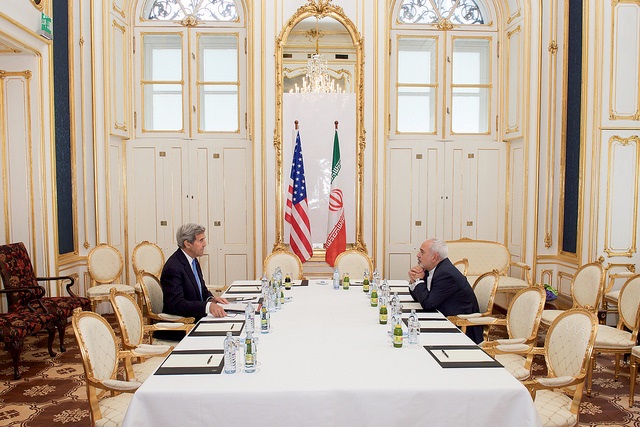Understanding the Limits of Sanctions
Editor’s Note: Sanctions are increasingly America’s foreign policy instrument of first resort, promising success without the bloodshed that comes with military force. Iran’s willingness to cut a deal over its nuclear program is likely to make sanctions proponents even more confident. But Peter Feaver of Duke University and Eric Lorber of Gibson, Dunn, & Crutcher argue that the United States risks relying too much on sanctions. They contend sanctions’ effects are difficult to predict and the targeting often goes awry.

Published by The Lawfare Institute
in Cooperation With

Editor’s Note: Sanctions are increasingly America’s foreign policy instrument of first resort, promising success without the bloodshed that comes with military force. Iran’s willingness to cut a deal over its nuclear program is likely to make sanctions proponents even more confident. But Peter Feaver of Duke University and Eric Lorber of Gibson, Dunn, & Crutcher argue that the United States risks relying too much on sanctions. They contend sanctions’ effects are difficult to predict and the targeting often goes awry. Sanctions should not be abandoned, but they should be used more carefully and as part of a broader strategy.
***
Since 2005, U.S. policymakers have increasingly turned to sophisticated types of economic sanctions as a foreign policy tool of first resort. From the development of banking sanctions limiting Iran’s ability to secure financing from Western capital markets to new sanctions targeting Russia’s financial system and the development of its oil resources, U.S. policymakers have touted these innovative tools as extremely powerful while also being tailored and precise. In his 2015 National Security Strategy, President Obama noted that “[t]argeted economic sanctions remain an effective tool for imposing costs on irresponsible actors” and that “[o]ur sanctions will continue to be carefully designed and tailored to achieve clear aims while minimizing any unintended consequences for other economic actors, the global economy, and civilian populations.”
In the case of Iran, the United States used its position as the financial capital of the world—and one of its largest markets—to essentially force foreign companies to abandon their business with the Islamic Republic. The U.S. Treasury Department threatened those companies with a choice: Either they could do business in U.S. financial markets (and have access to U.S. dollars for transactional purposes) or they could do business in Iran, but not both. As a result, a large number of foreign firms shuttered their business operations in Iran, increasing economic pressure on the country. This ability to impose what many countries argued were extraterritorial sanctions helped prevent Iran from easily finding alternative trade and financing partners, and was—at least in part—responsible for bringing the country to the negotiating table to discuss its nuclear program, ultimately leading to a long-term agreement with the P5+1.
Similarly, the United States has imposed sophisticated new sanctions on Russia that move well beyond simple prohibitions on transacting with certain of Vladimir Putin’s cronies. These new tools—which target Russia’s ability to refinance its massive external debt and prevent the country from developing key energy resources over the medium to long term—leverage key advantages enjoyed by the United States: technological superiority and attractive capital markets. A significant component of these sanctions prevents U.S. energy companies from providing cutting-edge technologies to Russian firms that would help those firms develop difficult-to-reach oil resources (such as shale, offshore, and Arctic resources). And like the sanctions aimed at isolating Iran from Western financial markets, U.S. and EU sanctions on Russia prohibit Western financial firms from dealing in new debt or equity with more than a 30-day maturity period, making it exceedingly difficult for Russian companies to secure the necessary financing to service the country’s massive debt.
These new forms of economic statecraft have proven powerful: As a partial result of the sanctions, economists are predicting that the Russian economy will shrink by 3.5 to 4 percent in 2015 and continue contracting in the medium term. Likewise, the Iranian economy suffered from significant inflation, and according to the Treasury Department sanctions on the Iranian petroleum industry cost the country $40 billion in revenue in 2014.
Policymakers, seeing the sophisticated nature and powerful impact of these sanctions, have concluded that these new tools of coercion are different from—and a marked improvement on—prior forms of economic punishment. In a recent speech, former Undersecretary of the Treasury for Terrorism and Financial Intelligence David Cohen noted:
[W]e have been able to move away from clunky and heavy-handed instruments of economic power. . . . [a]ll of us in this room remember how sanctions used to consist primarily of trade restrictions or wholesale bans on commercial activity. . . . [t]hese embargoes rarely created meaningful pressure. Sanctions that focus on bad actors within the financial sector are far more precise and far more effective than traditional trade sanctions.”
But while these sophisticated sanctions have imposed substantial economic costs on Iran and Russia and do collectively constitute a more capable tool for coercive diplomacy, the developing narrative—likely to be bolstered by what the Obama administration sees as successful coercive diplomacy against Iran—that increasingly sophisticated sanctions provide policymakers with a no-cost silver bullet for addressing intractable national security issues is wrong. These new sanctions can be powerful, but they often cannot be calibrated to the extent policymakers desire—or to the extent necessary to deliver strategic objectives. Indeed, it is more difficult than policymakers think to narrowly tailor these tools to achieve particular strategic objectives for at least two reasons.
First, the economic effects of these sanctions are unpredictable. In the case of Russia, U.S. and EU sanctions—combined with the drop in international oil prices and actions taken by Russian regulators—undercut the country’s economy to a far greater extent than expected or desired: By March 2015, inflation in Russia had risen to 16.9 percent. This followed on the footsteps of a near-run on the country’s currency, which was supposedly triggered by the Russian Central Bank promising to effectively print money to prop up certain companies owned by Putin’s cronies and hurt by Western sanctions. By the spring of 2015, Russia had spent approximately $130 billion of its precious currency reserves in an attempt to defend the value of the ruble and prevent it from sliding even further. In addition, by raising interest rates to 17 percent in an attempt to stabilize the ruble, the central bank has likely stymied consumer spending in the near term.
These new sanctions can be powerful, but they often cannot be calibrated to the extent policymakers desire—or to the extent necessary to deliver strategic objectives.
Although these economic effects are profound, U.S. policymakers did not anticipate them and did not intend to cause them. Collapsing Russia’s economy would cause many more problems in the region than it would solve, and if the Obama administration wanted to seriously undermine the Russian economy, it could have easily done so by designating a number of Russian banks and directly freezing them out of the U.S. and European financial sectors. This action would have been a far simpler and more direct way to cause Russia economic pain and bring it to the negotiating table over the Ukraine issue. These new, sophisticated sanctions were instead designed to hurt a specific subset of Russian companies, namely those that are owned or controlled by Putin’s inner circle or directly run by the Russian government.
Second, the political effects of these sophisticated sanctions are also difficult to predict. In the Russian case, U.S. policymakers developed the sanctions to target Vladimir Putin’s inner circle, believing this would cause them to pressure the Russian president to adopt a different course in Crimea and Eastern Ukraine. But although the sanctions have damaged the economic interests of these individuals, the result has been the opposite of what policymakers intended: Instead of pulling out of Crimea and ceasing Russian support for the rebel forces in Ukraine, President Putin requisitioned property of more liberal oligarchs and consolidated the position of hardliners within the political, military, and economic sectors. For example, in October 2014, Russian authorities seized Russian businessman Vladimir Yevtushenkov’s oil company Bashneft and effectively nationalized the company in what was seen as an attempt to secure resources for the Russian government and to reallocate the company to Putin’s allies.
Likewise, Putin has reportedly sidelined even those conservative oligarchs who have supported him thus far during the crisis and has instead relied on the advice of a small group of military and security officials. These officials have further encouraged Russian support of separatists in Eastern Ukraine and a generally confrontational approach to the United States and the European Union. In other words, the sanctions may have actually made it more difficult for the United States to achieve its goals in the conflict.
This is not to say sanctions were not the best tool to employ against Russia. The art of foreign policy decisionmaking often requires leaders to choose between a set of suboptimal alternatives. In this case, the other options may have been far less attractive. For example, simply issuing a sternly worded demarche in response to Russia’s annexation of Crimea would have telegraphed irresolution and may have encouraged Russia to engage in more aggressive activity in Eastern Ukraine than it already has. Likewise, threatening to use military force could have lacked credibility or, if believed, escalated the conflict significantly, and providing active military assistance to Ukraine could certainly have escalated the conflict significantly. In comparison, these new sanctions are attractive in large part because they can be imposed unilaterally (or with minimal allied support), quickly, and seem to involve less risk than other forms of coercion such as using military force.
To better understand their strengths and limits, U.S. policymakers should more carefully study the likely impacts of these sophisticated sanctions prior to imposing them. The Obama administration would be well served to create an interagency working group to closely examine the likely economic and political impact of new sanctions before imposing them. Yet we must not kid ourselves about our ability to predict effects with great confidence: These sanctions are more powerful than earlier generations of tailored “smart sanctions” precisely because they have a multiplier effect beyond the direct control, and thus beyond the confident predictions, of policymakers. To be sure, economic sanctions may still often end up being the best alternative to doing nothing or to escalating to military force, but policymakers need to realize that sanctions are not silver bullets, despite their many strengths.
Even if policymakers decide that sanctions are the best tool, they should not rely on them in place of a strategy, but rather should incorporate them into a broader strategy for safeguarding U.S. strategic interests. Sanctions—even sophisticated ones—are rarely effective alone, and must be used in conjunction with other tools of diplomacy to have much chance of success. Part of the reason that the United States was able to bring Iran to the negotiating table and ultimately strike a deal with the Islamic Republic was that it combined the offer of extensive diplomacy with the threat of force, sanctions, and other forms of coercion over a multi-year period. To be sure, the mix was hardly optimal. The threat of force was stronger at the initial stages of the contest and essentially disappeared during the endgame, and sanctions, or at least the prospect of sustaining sanctions, began to wither in the final months as well. Critics have made a strong argument that a much better deal could have been achieved if the Obama administration had been able to match its negotiations intensity with a sustained credible threat of force and a sustained credible threat of additional sanctions in the absence of a deal. Regardless of where one comes down on whether the Iran deal is good enough, the basic point stands: whatever the economic sanctions were able to accomplish with Iran were accomplished only because they were integrated to a larger strategy, initially laid down by the Bush administration and later expanded by the Obama administration, that combined economic pressure with military, diplomatic, and other forms of pressure.
Even if policymakers decide that sanctions are the best tool, they should not rely on them in place of a strategy, but rather should incorporate them into a broader strategy for safeguarding U.S. strategic interests.
By contrast, from the outset of the recent conflict with Russia, the Obama administration relied almost exclusively on sanctions to convince Putin to cease his support of rebels in Eastern Ukraine and pull out of Crimea. This did not prove successful, and while the jury is still out, providing additional economic assistance to Ukraine and bolstering NATO’s ability to respond to Russian aggression throughout Eastern Europe may better convince Russia to cease threatening its neighbors and supporting separatist activity in its near abroad.
The new sanctions provide policymakers with a powerful tool, one that may well seem more efficacious than the other tools available. But well-crafted sanctions are unlikely to salvage a poorly crafted strategy—and a president who resorts to sanctions because he does not know what else to do and is unwilling to pursue a tougher line may not see much benefit, either.
A longer version of this article appears in the July/August issue of the National Interest.





